After viewing the Chagall drawings at the Israel Museum, we visited the Jack, Joseph, and Morton Mandel Wing for Jewish Art and Life. Inside this area, we found an amazing collection of items that date from the Middle Ages to modern times. There are 5 designated areas:
- The rhythm of Life: Birth, Marriage, Death
- Illuminating the Script
- The Synagogue Route: Holiness and Beauty
- The Cycle of the Jewish Year
- Costume and Jewelry
To give a taste of what is on a display, I will share a few photos.
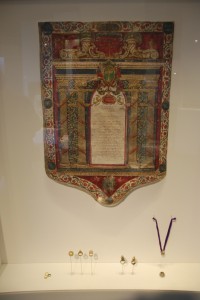
Handwritten on parchment; ink, tempera, and gold powder

Tétouan, Morocco
Late 19th century
Silk velvet, metal-thread embroidery on cardboard cutouts, silk, metallic ribbons

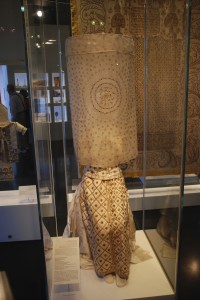
During the wedding ceremony in Cochin, the bride would sit near the Torah Ark in the synagogue with her body partially concealed by a veil hanging from the ceiling. Only her skirt would be seen. The skirt would later become a ceremonial object for the community. Sometimes it could be used as a cover for a coffin before burial while other times it could be used as a Torah Ark curtain.
The Synagogue Route: Holiness and Beauty
Synagogues have varied greatly from time-to-time and from place-to-place. All will have a holy ark that houses the community’s Torahs and a raised platform where the rabbi and/or cantor leads the community in prayer. This exhibit captures the unique beauty of 4 different communities. The interiors of these structures were carefully disassembled, labeled, and shipped to Israel. At the museum, the synagogues were reconstructed piece-by-piece. The exhibit showcases the diversity of Jewish communities in various parts of the world as well as the common religious traditions that bind the Jewish people together.
I am sharing 3 of the 4 communities.
Vittorio Veneto Synagogue
This small Ashkenazi synagogue was located on the second and third floors of a simple building in northern Italy. By the end of the 19th century, the Jews were moving to urban areas. By the end of the World War I, the synagogue had been abandoned.
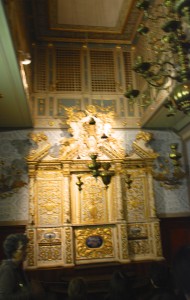
Northern Italy
Elegantly designed in typical Italian Baroque style
Kadavumbagam Synagogue
The Kadavumbagam (“by the side of the landing place“) synagogue was originally located at the edge of the Jewish neighborhood in the town of Cochin, India. It was one of eight synagogues in the area. The carved wooden interior includes an intricate ceiling featuring motifs similar to ones found in local mosques and Hindu temples. It has two reader’s platforms- one used on Sabbath and holidays and the other for daily prayers. Cochin was once a vibrant Jewish community. Today, only a handful of Jews remain.
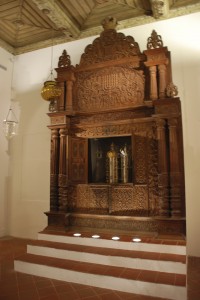
Kadavumbagam Synagogue
Date of construction: 1539–44
Cochin, Southern India
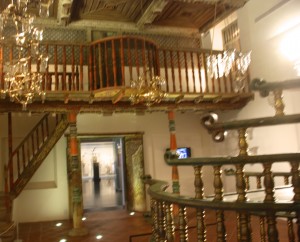
Cochin, Southern India
Wooden decoration: 17th–18th centuries
Teak wood, carved and painted
The Tzedek ve-Shalom Synagogue
In 1736, this synagogue was founded in Paramaribo, the capital city of Suriname (country on northern coast of South America). It is an example of Spanish and Portuguese synagogues in the New World. Jews who had fled to Holland during the Inquisition, were among the early European settlers in Suriname.
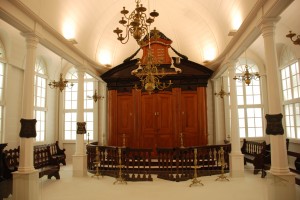
The Tzedek ve-Shalom Synagogue
Paramaribo, Suriname
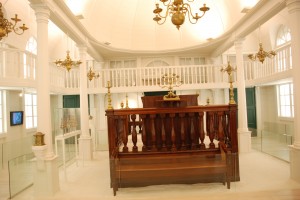
The Tzedek ve-Shalom Synagogue
Paramaribo, Suriname
Even though these sanctuaries are no longer being used by their respective communities, the history and the beauty of these structures can be appreciated by anyone who visits the Israel Museum.
Sandra Bornstein is the author of MAY THIS BE THE BEST YEAR OF YOUR LIFE. It is available on Amazon.
If you enjoyed reading my memoir, consider posting a review on Amazon, Goodreads, and/or AskDavid.com.
Sandy, this is a great site and enjoyed the photos and information provided.
Steve and Sally,
Thanks for taking the time to comment. The Israel Museum is an amazing place.